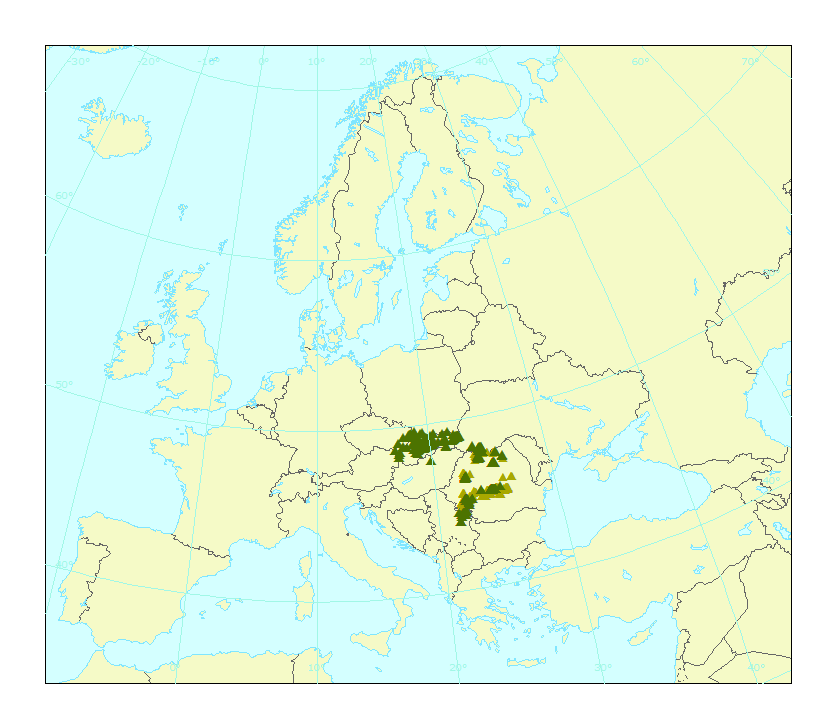forest conservation
Type of resources
Available actions
Topics
INSPIRE themes
Keywords
Contact for the resource
Provided by
Years
Formats
Representation types
Update frequencies
Scale
Resolution
-

The virgin forest inventory data set includes the location (point) of the last virgin forests identified by each Carpathians Convention Member, namely Czechia, Hungary, Romania, Serbia, Slovakia, and Ukraine. The data set does not include plots from Poland, since no official inputs have been submitted yet. An additional layer presents the quasi virgin forest plots provided by Romania. The virgin forest inventory inputs were collected and validated in 2019. The attribute table indicates, when available and along the virgin forest location, additional information as the official name, size, the county to which it belongs, altitude, level of protection, the forest type according to the national classification and its correspondence with the European Nature Information System classes (EUNIS). The Carpathians area of study is delimited by the Carpathian Environment Outlook (KEO) boundary.
-

The natural assemblage species indicator dataset is a forest dataset that measures the congruency between the potential and current tree species distribution. The natural assemblage indicator is considered one of the key indicator for the identification of High Nature Value forest area in Europe. The reference year for this data set is 2006 and the spatial coverage is including the 28 EU Member States, Liechtenstein, Norway, Switzerland, and Turkey. The methodological approach is based on two data sources: (1) EUNIS woodland, forest and other wooded land habitats, predicted potential distribution of habitat suitability –EEA- as potential distribution; (2) Relative probability of presence of forest tree species (RPP) of European Atlas of Forest Tree Species –JRC- as current distribution The dataset values express, in the fuzzy values between 0 and 1, the percentage of tree species vegetation agreed with potentially dominant tree species by pixels. This measure is independent of the current forest coverage. The values close to 1 mean high percentage of native tree species (natural) whereas values close to 0 are an approximation of a low level of naturalness, being a high percentage of non-native species.
-

This dataset refers to the Richness index of Species and Habitats of Conservation Concern indicator. This indicator has been developed to be used as a sub-indicator for contributing to the identification of the High Nature Value (HNV) Forest Areas as it will be integrated with other sub-indicators of horizontal structure, management and naturalness to generate the final composite indicator. It is composed itself of three sub-indicators: “Forest Non-bird species”, “Forest bird species” and “Forest habitats”. All the three sub-indicators build on distribution data from the reporting of habitat and species conservation status under Article 17 of the Habitats Directive and Article 12 of the Birds directive which describe their distribution at 10km grid resolution. The forest species and the forest habitats proposed to be used for the HNV forest area identification were selected based on expert judgement (ETC/BD) and raster files reporting the count of forest species and habitats were created. At this stage, no weight is applied based on Habitat and Species prioritization, conservation status or endemism. The sub-indicators were then normalized for each European forest type and successively combined not assigning any specific weight to a particular sub-indicator. The values for this indicator, present in this dataset, ranges between 0 and 1. The values close to 1 mean high presence of habitats and species related to forest, whereas the lower richness are closer to 0. It covers the forested areas of the EU 27 (2007) Member States except for Cyprus (data from Croatia will be reported starting from the next update regarding the period 2013-2018).
-

Forest management involves various degrees of human intervention to safeguard the forest ecosystem and its functions as well as the exploitation of forest resources. While the objectives of management vary widely and include the protection of resources in protected forests and nature reserves, the primary objective is mostly the production of wood products. Although sustained yield forestry continues to be widely practised, there is an increasing trend towards the management of forests as ecological systems with multiple economic benefits and environmental values, ensuring that benefits meet present as well as future generations’ needs. In order to assess forest management intensity in Europe an indicator based on three data sources has been developed: a) Fast track ecosystem capital accounts (forest growth & harvest – disaggregated to 1km grid), b) Potential forest management (gradient of intensity of intervention with the natural processes in a forest) c) Forest fragmentation (forest ecosystem network connected by forest bridges – GUIDOS Morphological Spatial Pattern Analysis). Each input dataset has been assessed separately in a first step in terms of pressures on forest ecosystems which are the result of the specific management, use or respectively state of the forest patch. The overall management related pressure is then derived by crossing the relative pressures by each input and evaluating the constellation of the input representative factors. This updated version of the management related forest pressures is based on the first assessment done in framework of the ETC-SIA report "Land use and land management related pressures on agricultural and forest ecosystems" (ETC-SIA, Task 1.8.4.3 Ecosystem pressures).
 RUC Geo-Data catalogue
RUC Geo-Data catalogue